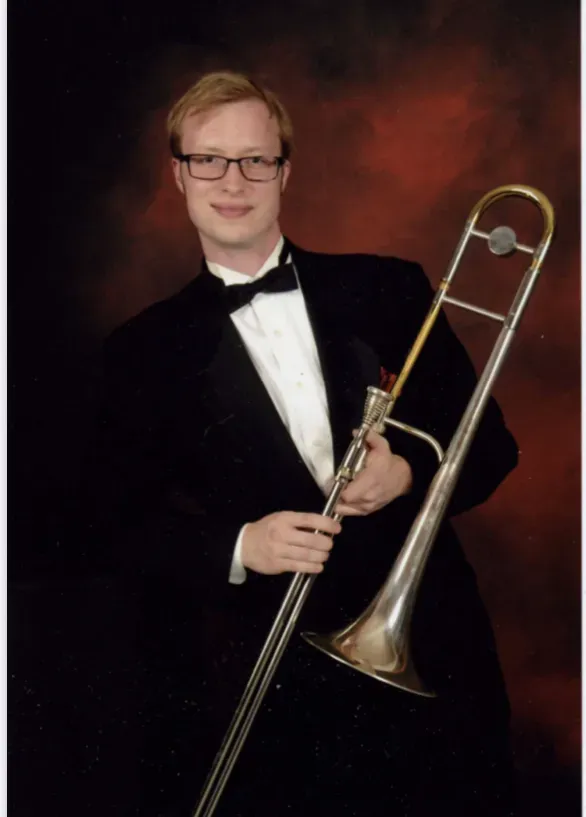Trombone Overview
The trombone is a large brass instrument with tubing that has been split into three distinct sections. The tubing begins narrow at the mouthpiece and ends in a open bell that extends over the players left shoulder. The trombonists then slide the tubing with their hand to adjust the pitch. When the tube is moved out into a longer position the air travels further creating a lower pitch. A popular instrument since the 16th century, the trombone was used primarily in orchestras for classical, jazz, and pop music. Today, however, trombones have branched out further into the musical world to be included in marching bands, brass bands, military bands in swing music, jazz, merengue, R&B, and Ska.
Trombone History
The trombone as we know it today has not changed much over the last 500 years. The predecessor of the trombone was an instrument called a sackbutt. With a curved tube that looked similar to the curves of a paperclip, the sackbutt had an extended sliding section and registered as a tenor. The earliest surviving sackbutts today are dated from the 1500s.
The word trombone means “large trumpet” in both Italian and German. In pieces of music calling for a loud volume, band directors typically rely on the trombone to fill the need. The extended tubing allows for a robust, low and loud sound. This bombastic quality of the trumpet became a desired asset, and later the bells of the trombone were widened to expand the volume of its sound.
Unlike many other brass and woodwind instruments, the trombone has been a fully chromatic instrument since the beginning of its creation. Most other instruments required centuries of experimentation and innovation to produce the full chromatic scale, however with none of these issues holding it back, the trombone has made gains toward the most popular brass instrument.
Types of Trombone Instrument
There are many types of trombone instruments being used across the world today. Trombones range in a variety of pitches, beginning at cimbasso.
Cimbasso is most frequently pitched in the key of F, Eb, C and occasionally Bb. The cimbasso trombone features three to six piston or rotary valves and a predominately cylindrical bore. Due to the valves, the cimbasso is able to perform faster techniques.
Next in pitch is the contrabass trombone. This trombone is generally pitched in 12’ F, a fourth lower than the more modern tenor and bass trombones. Today it is common for most opera houses and orchestras to need the bass trombonists to be proficient playing the contrabass as well.
Bass trombone is next pitched in Bb. The bass trombone is the same as a tenor trombone except it has a larger opening (bore), a wider bell, and a bigger mouthpiece. These features provide a darker and weightier tone.
The tenor trombone is typically treated as a non-transposing instrument and has a fundamental note of Bb. With no valves, crooks or keys to alter the sound, the trombonists rely solely on the seven chromatic slide positions. Each position increases the length of the tube, therefore lowering the pitch.
The higher alto trombone is pitched in Eb or F and has a shorter slide that makes it the instrument used to play the higher notes in the brass section or choir. This instrument is primarily used in choral, orchestral and operatic settings.
The soprano trombone is typically pitched in Bb, an octave above the tenor. This is the highest-pitched of all the trombones. The modern soprano trombone has short slides of only six positions and a trumpet-sized bell. The trumpet mouthpiece also lends to more of a trumpet sound rather than that of a trombone.
The type of trombone one chooses to play will depend on their musical endeavors. It is best to decide how your trombone will be used primarily before purchasing an instrument of your own. This ensures the instrument may meet your demands.
Trombone Playing Techniques
There are a variety of techniques that may be used with the trombone to incorporate unique ornamentation to your music. Listed below are some of the more popular trombone techniques:
• Air Noise - Blowing through the mouthpiece without lib vibrations can create a whistling sound from the bell of the instrument. This whistle can be further manipulated by sliding the scales.
• Flap Tongue - Flapping the front or back of the players’ tongue against the mouthpiece during plat can provide an element of percussion to your sound.
• Microtones - Playing notes smaller than a semitone is simple to do on the trombone providing the opportunity for the player to incorporate musical nuance.
• Removing Parts - By removing portions of the tubes in the trombone, a player may raise or lower pitch, or vary the volume of their music.
Trombone Mechanics
A trombone musical instrument is comprised of eleven different components, all that play a part in the quality of sound.
1. Tuning Slide - Used for tuning the instrument
2. Counterweight - helps the player balance the instrument as it is played.
3. Brace/Strut - a metal rod that runs horizontally across the tubing to secure it in place.
4. Mouthpiece - Directs air and vibration from the player's lips into the body of the instrument.
5. Mouth Receiver - connects the mouthpiece to the trombone
6. Valve Slide - Allows the player to change the length of the trombone's tubing to produce different tones.
7. Valve Pistons - Metal cylinders that move up and down inside the castings to change the length of the tubing internally.
8. Valve Castings - Metal tubes that hold the pistons of the valve while they move.
9. Water Key - Allows the player to quickly remove moisture from the inside of the trombone.
10. Bell - Where the sound emerges from the instrument.
Notable Trombone Musicians
Many trombone players have achieved stardom during their careers. The unique and varying sound of a trombone can be applied to nearly any musical genre allowing a great deal of opportunity in the musical world. Some of the most renowned trombone players today are:
- Andrew Rozsa (View his course)
- Colin Pulkrabek (View his course)
- J. J. Johnson
- Glenn Miller
- Curtis Fuller
- Steve Turre
- Bennie Green
- Annie Whitehead
- Carol Jarvis
- Melba Liston
- Natalie Cressman
- Sammy Braganza










